A exhibition of art that depicts Iraq’s reality
The eighth Tarkib’s festival for modern arts has begun.
This festival is a very unique type of the festivals that are held in Baghdad, and I went there for the purpose of having fun, but what I saw made me think that I need to write about it. So, I’ll take you on a virtual tour inside the festival with me.
The location of the festival was inside the Iraqi Artists Syndicate building which is in Al-Tahrir beach and it’s a very old Baghdadi building. As soon as we arrived all the memories of Tishreen flashbacked in my mind considering that this place is exactly where we used to hangout during October’s Uprising.
As I was taking a glance at the place, I noticed that the sand of the beach was being shoveled off the shore of Tigris River which made me feel a little sad but in the end it’s the right thing to do for our dear Tigris. And we will discuss this issue in a bit.

As soon as we entered the place there’s a unique way to register for the festival. You’ll get a very warm welcome and get your hand stamped with the logo of the festival and you’ll get three extra items, a sticker, a review card (to write your feedback on the festival) and a map to guide you through the building with work. I’d kindly ask you to discover this map with me.



As you enter the place you can hear the Arabic folk music and poetry travelling around the walls of the building reaching out to your ear and dragging to go and see the source of these amusing sounds, until you find yourself inside the inner yard of the building to see the grassroots bands and poets.


The first artwork will catch the attention of your eyes as soon as you enter the inner yard of the building is as you can see how it looks below, the Artist Ali Zyaid came to us as we were admiring his work and told us: “What’s the first thing that came to your mind”, the art name is “Tectonic Freedom”. Tectonic is an architectural term which means the art of construction, he used the tectonic style to express Nietzschean perspective of freedom, and how that everyone thinks that they’re free but only few people are truly free (represented by the two shining poles).

While you were in the registration room, you’ll see an open door that is covered by cloth with water coming out of it with a sign hanging next to it that says “Concrete o by Zaid Saad”. As your curiosity takes you to get between the cloth to enter the door, you’ll get stunned by a very weird theme as you can see below, with a small layer of water beneath you with life rings made out of concrete. There are writings on the wall in both English and Arabic saying: “Is this life ring, that is offered to refugees really a life saver?
Is the refugees treated like a human being?
Does the life ring save the refugees upon arrival or is they drowning of another kind?”
The message that the artist is conveying here is that refugees in the western world are not being treated properly like human beings and these life rings are not going to help, when they arrive, new problems and challenges will be facing them which is another form of drowning.



Next to the beautiful art piece of “Tectonic Freedom”, you’ll see a room that will catch your attention to the fact that you’ll see sand coming out of it with a sign hanging next to its entrance saying “Spot”, so you’ll wonder what’s happening there! When you enter the room, you’ll see the sand covering a significant layer of the room. You’ll see the artist Mohannad Taha laying in it. When you’ll ask him what’s this about? He’ll say, “It’s a spot for me to relax” and this sand is actually from the Tigris River beach (Tishreen Beach). This sand holds a lot of memories for those who participated in Tishreen and when we saw it being shoveled away, we were very sad as we mentioned above, so Mohannad decided to mortalize this sand by bringing it to this room. It was also considered a form of advocacy for Tigris River and to highlight this rich sand that is also getting smuggled outside of Iraq to be used for Agriculture.




As you’re walking out from “Spot” you’ll see a cage in the middle of the yard with solution bottles hanging inside of it. As you’re getting closer you’ll see a sign at the bottom of the cage that says “Waiting by Husam Mohammed“, the artist explained that there’s a story behind this peace, his dad had cancer and it was discovered in its early stages, there was a special treatment for his case which was provided by the government, and just like any other thing you want from the government, you’ll have to go through a long and bureaucratic procedure to have it. Therefore, the paperwork of this treatment took months, while the patient was waiting for the treatment, his condition kept going downwards. Every bottle represents a bureaucratic position, starting from the Minister of health as the top bottle, reaching to the last bottle which represents the hospital, the iron cage stands for firmness and patience. As the treatment was agreed upon and was ready to be provided, unfortunately it was too late for his dad’s condition.

As you’re still looking around in the yard, you’ll see a room that you haven’t entered yet, there is also a sign on it that says “Childhood Anxiety” as you get closer to it, you’ll see the artist himself Atef Al Jaffal, being chained inside the room with his body language conveying insecurity and depression. This art piece represents mental issues that the Gen Z and Millennials are facing nowadays. The show starts with birth, the artist is an innocent state, as he grows up he interacts with a traumatic incident that makes him suicidal, and he ends the audition with a sleeping state. The low lighting represents the uncomfortable feeling of youth and the chains represent the traumatising memories that keep us tight up our whole life. The artist will interact with every individual that enters the room according to his energy, conveying the message that they’re not alone.




As you’re hanging out in the yard you’ll see a big gate that leads to the garden, you walk into it for fresh air and you’ll see a big board in the garden with big 3 papers on each side of it. At the bottom of it you’ll see the name of the piece which is “1000 Stories and a story vol2”. The artist Hussain Muttar will greet you and start explaining to you that these papers have 2 pictures of Baghdadi sites at the same place but at different times. You’ll notice a lot of changes in those sites from the old picture to the new one. Those sites are Al-Rasheed Street, Al-Qishla Street, Kahramana Square, Al-Aa’lawi and Haifa Street, Al-Tahreer Square and Al-Khullani Square. Hussain will convey to you how bad he feels about ripping off the Baghdadi identity of these sites and how these artistic sites were sabotaged during the changes of the political systems. The work was called “Vol2” because Hussain had a book on the same subject written back in 2018.


In the same garden as “1000 stories and a story”, there’s a big stage with chairs in front of it. This stage is made for short films presentations. During the days of the festival there were many films that were on that stage, such as “BLACKED OUT” by Hajer Qusay (Drama and Psychological Thriller), “Haiko” by Mounir Salah (for Tishreen martyrs), “Last Dream” by Malak Abd Ali (Drama) and “50/50” by Khalid Nasser (Drama).

So you finished the ground floor of the place and your curiosity begins to itch your mind, encouraging you to get up and discover the top floor. So you take the stairs up to a cross hallway, you see lots of rooms on your right, and a big gate with a curtain on your left, as hesitancy hits your brain while trying to decide quickly, you take the left path. You walk through the curtains, you see a lot of things going on there. To your right, you’ll see a weird combination of items and on the wall next to it you’ll find a sign that says “DISEASE by Hajer Qusay”, you try to step away from it to comprehend the art work, you’ll notice the green fluid bottles and try to remember what the colour green stands for in art? Which stands for disease. As an Iraqi, you’ll understand that the statue covered with white cloth stands for the Arabic term of a “woman’s Honour”. Collecting these informations can form the full picture of this piece. This artwork stands for Iraqi women’s struggle, as a beautiful woman who always is exposed to criticism and harassment, and those green bottles are the society, feeding those women with disease and toxicity instead of support and Help.

To the left of “Disease” you’ll see another weird item, you get close to it, you see a sign next to it that says, “LIFE & DEAD by Aisha”. This artwork is a sculpture made from plastic glass that implies that not everything we see is the absolute truth (Conscious and subconscious levels).

There’s a door next to “LIFE & DEAD”, it looks dark and you start to wonder what’s there? Until you find yourself in that very room. You’ll see a projector that is pointed towards the opposite wall and there’s a sign next to that projector that says “Grown Up Village by Sirhand Khalid”. This video conveys how human beings have lost connection with city architecture.


The left side of the top floor has reached an end, so you decide to go for the right side of it. You’ll face a sign in the hallway that says “Watch Out! And be connected with your senses” and in front of this sign, there’s a door, you walk into that door to see a bunch of art pieces around the room. The first thing will be a painting right in front of you as you walk in, there’s a sign next to it that says, “QUESTIONING THE QUESTION by Noor Abd Ali” The surrealist painting is conveying a daily routine of her life as she walks through Al-Sinak Area every day going to her work. The men that work there ask her aggressively: What is a woman doing in the middle of a market full of men? The violet color is an expression of her innocence between the red objects that express the aggressive question.

To the left of the painting, there’s another projection with a dress in front of the screen. Under the projector there’s a sign that says “SOUL by Zinah Kareem”. The projected video is the artist visualising her mom’s soul wearing her dress in the video walking the streets of Baghdad as if her mom is still alive. There’s music in the background of the video that was produced by Dyar Ziyad.

As you look behind you, you’ll see people wearing a VR Device and looking very stunned. Your curiosity made you go and take a look by yourself. When you put on the VR, you’ll see very trippy visuals and you’ll see a sentence in the sky that says “COSMIC GARDEN by Amir Akram”. The garden is made up of 10 levels. As you walk through them, you’ll be very astonished by what you’ll see. And finally when you take them off, you’ll be walking in a very dizzy way for a couple of minutes.

As you’re still trying to comprehend what you have just seen with the “COSMIC GARDEN”, you’ll see a door next to you with a sign next to it that says, “REFLECTION by Jumana Ridha”. You decide to walk through that door, and you’ll see a bunch of paintings laying on the walls. The room is a reflection to certain moments that Jumana has lived. The main painting represents her childhood, she was very scared and anxious of people. Her sister’s hand Marina and Christina were holding her and helping her. The opposite painting describes the moment where both of her sisters have gone in different ways and left her alone. One hand is scared and lonely, while the other is trying to find different ways to survive. The third painting with flowers under her eyes is her collapsing point. She realized that her fear of people has come from her ability of empathy, and she has accepted this fact. After her breaking point, her sister Fatima gave her comfort in her life in the fourth picture. The final painting is dedicated to her mother. We see that her mother was wearing black all of her life because she lost close people to her most of her life. The flower represents the mission of her mother to care and give to all of her children.


There’s another door in the same room of “REFLECTION”, you decide to go through it and you’ll see a big painting hanging on the wall with a sign next to it that says “OVERTHINKING by Furqan Mohammed”. The painting is an expression of the artist thinking over and over again in the same problem without concluding any solutions. The cubic shape is her brain while the black background is the dark room which represents her mind, the big eye is viewing life from one perspective, and the colourful theme represents her will to see life in its fullest and she paints to get rid of her overthinking.

There’s also another door in the room of “OVERTHINKING”, as you walk through you’ll find the yard to your below right, and a beautiful balcony that overlooks the Tigris River. There’s also another door in front of you that takes your attention to walk into it. Entering the room will cause an instant confusion due to what you’ll see. You’ll see a frontline shield that is based on sand bags that are used in wars, only this time, instead of weapons, you’ll see musical instruments and books. There’s a writing on the wall that will explain everything to you: “When intellectuals face ignorance”. This peaceful and meaningful piece of art was made by Diyar Ziyad.

As you’re walking out, stunned by Diyar’s work, you’ll see a side of the top floor that you haven’t discovered yet. As you walk to it, you’ll see a bunch of paintings presented in one row, all black and white with the colour red isolated out of it. The work is named “RED 20 by Lwaa Alhasanee”. And the reason behind this naming is that the artist thinks that the colour red is as important as water (H20). Lwaa asked the visitors what does the colour red mean to them? The answers varied from love, anger, excitement, power, pride, danger, boldness to warmth. And he was curious how red feels mixed with the other colours of life.

As you’re admiring these beautiful paintings, you’ll hear the clucking of a chicken coming out of the stairs next to the paintings, you’ll also see next to the stairs, a sign that says “KNEELING by Loay Alhadhary”. As you walk up the stairs, you’ll enter a very small room with a featherless chicken shaped toy and a clucking sound played on loop, there’s a chair in the middle of the room and the chicken is standing in front of it, the feathers of the chicken is scattered in front of the chair with seeds also in front of the chair.
Luckily, you had a friend with you who is very intellectual when it comes to art. They say based on the sign (KNEELING), and the fact that the chair gives an impression of an authoritarian figure, and the chicken is being oppressed by ripping its feathers by this figure, yet it’s still submissive to that figure because they give it seeds. And when we asked Loay the artist, he said it’s a personification of the famous story of Stalin and the chicken. And how it is relatable to the Iraqi political situation.

I wasn’t really engaged in the arts before the festival, but now that I’ve left it, I find myself searching everywhere for artistic forms and pictures. I’ve learned a lot from this experience, and I believe that using art to advocate for causes and spread awareness is a really powerful strategy. We may observe how those artists spoke freely without saying a single word, how the reality was conveyed with no interruptions.
- Written by the Editor of ICSSI Ramiz Majeed




